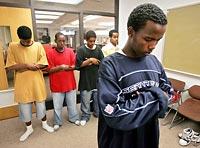
Muslim students get help juggling school and faith
By David MontgomerySeattle Times staff reporter
Abdisiyad Adan leads fellow Muslim students in prayer in a library conference room at Seattle's Nathan Hale High School. Behind Adan, from left are Hunde Hussein, Daraaraa Waqo, Amer Ali and Ismail Hamza.
On Friday afternoons, Nathan Hale High School senior Abdisiyad Adan asks his fifth-period teacher what he'll miss in class, writes down the homework for the weekend and leaves school.
Other Muslim students at Nathan Hale pile into Adan's car, and they set off for the Idriss Mosque a little more than a mile away. By the time they return from their mandatory Friday prayers, the school day is nearly over.
Adan's situation reflects the difficulties that the Seattle School District, and other public schools across the nation, face when dealing with Muslim prayer. Federal and state law prohibit teacher-led prayers in public schools, as well as student-led prayers at school events or religious programs. But laws protect the right of students to pray, and educators often struggle with how to accommodate students without disrupting class.
In Islam, prayer five times per day is obligatory. Adherents must face in the direction of Mecca and engage in a series of ritual movements. One of the five daily prayers must occur around midday, and on Fridays, the Muslim holy day, the midday prayer is supposed to occur in a mosque.
Seattle School District guidelines give school administrators the responsibility of deciding how to handle Muslim prayer.
At Garfield High School, an empty classroom is provided for Muslims to pray during lunch periods, Principal Ted Howard said. Students who don't want to miss lunch can have an extra 10 minutes to pray after the lunch period provided their teachers sign off on it. On Fridays, Muslims are allowed to go to a nearby mosque.
"As long as we have the space, and people are willing to step up and help us out, we're willing to accommodate most students' needs," Howard said.
The district's Office of Equity and Race Relations has established a committee to examine the needs of Muslim students, and the ways the district can address them.
The Seattle area is home to an estimated 40,000 Muslims, and while Seattle Public Schools doesn't track religious affiliation among its students, officials believe the number of Muslims is growing.
Caprice Hollins, the district's director of equity and race relations, said that over the past several years, administrators and teachers have contacted her with questions about Muslim students' needs. She said the committee isn't trying to come up with policy but rather to provide information to staff members about Muslim culture.
"People [have to] have some tools [to] help teachers and principals answer questions about Muslim students," said Hollins. "Certainly [some] schools are already doing a great job addressing the issue of prayer ... but there are also schools that struggle in this area."
In Shoreline, Muslim students are provided with an empty classroom for prayers and are usually allowed to miss class for their prayers. Shorewood High School senior Omar Sarhan said teachers sometimes suggest that students remain in class for particularly important assignments.
In the Edmonds School District, the issue of Muslim prayer has been raised at only one school, Edmonds-Woodway High, where two Muslim students are provided with prayer space to be used at the beginning or end of class periods.
Early missteps
But the issue can be a sensitive one, as is the case in the Seattle district.
An early advertisement soliciting members for the committee referred to it as the "Prayer in Schools Committee" — a name Hollins now describes as "naive." The name has been changed to the Religious Accommodations Committee, and while the focus remains on Islam, Hollins said, the committee is open to concerns about whether the needs of other students, such as Jews or Buddhists, are being accommodated.
Hollins was appointed in 2004 to encourage awareness of cultural differences, promote equity and access to the school system and eradicate what the department refers to as "institutional racism."
The definition of that term, as posted on the department's Web site, recently sparked controversy. The site contained a number of definitions of different types of racism, and gave "individualism" and "defining one form of English as standard" as examples of "cultural racism."
The definitions were later removed, replaced by a message from Hollins that said the definitions lacked context. The message also explained that the department rejected "unsuccessful concepts such as a melting pot or colorblind mentality" — positions that remain controversial.
Focus on Muslims
Some critics believe focusing just on Muslim prayer reflects a bias against Christianity. Others say the effort gives too much attention to one group.
Andy MacDonald, a Ballard resident who contributes to the blog Soundpolitics.com, said the committee appears to be dealing only with Muslims because they've made their concerns heard.
"If they're going to have a broad district policy, they should have a policy for prayer in general [without exceptions]," he said.
Hollins said that Muslim students are unique because they have a particular time of day when they need to pray.
"For myself as a Christian, while I pray every day, there's not a particular time that my supervisor needs to know [about]," Hollins said.
American Civil Liberties Union of Washington spokesman Doug Honig said a series of U.S. Supreme Court cases justifies the Seattle district's efforts.
Adan said that Nathan Hale teachers and administrators had been very helpful in providing a room for prayer and allowing students to miss class, but, he said, it can be a problem elsewhere.
"For all Muslims, prayer is ... significant," Adan said. "When you have to choose between prayer and school, it's tough."
David Montgomery: 206-464-3214 or dmontgomery@seattletimes.com
No comments:
Post a Comment